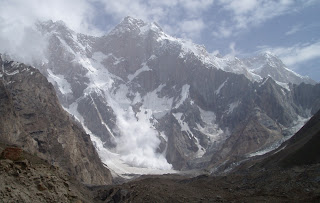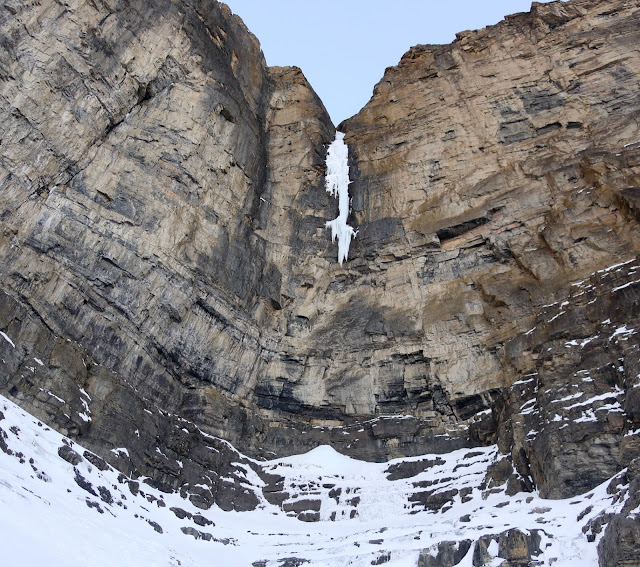There but for the grace of a great imaginary being go I.
I like to believe I can be in control in the mountains; that if I make all the right decisions I will come through unscathed. Sure, at times I do take calculated risks. For example in 2006 three friends and I traveled to Pakistan to attempt the southwest face of unclimbed Kunyang Chhish East (ca. 7400 m). The face is both huge (it rises two and a half vertical kilometres from the glacier) and beautiful (a subjective assessment, but I for one find it intensely compelling). I might also add dangerous, as the lower part of the face is threatened by multiple serac bands. They do not calve very often, but when they do the resulting avalanches are truly apocalyptic.
As one of my alpine mentors once told me before I went to climb the serac-threatened Gimme Shelter, The worst of it is that if anything happens, people will say, What were they thinking?
... and again on Tuesday. Photo: Grant Statham.
A serac avalanche sweeps down the southwest face of Kunynag Chhish East.
We made two ultimately unsuccessful attempts, stopped by illness the first time and by excessive heat the second. Both times we left basecamp at midnight and scrambled over giant fields of avalanche debris in the dark. Both times we retreated in daylight and walked down through the no-man's land in broad daylight. On all four occasions we were playing Russian roulette, having judged from the relative infrequency with which the seracs went that most of the chambers were empty. But if something awful happened we would not have been too surprised.
Ian Welsted climbing up the barrel of a gun at the base of the face...
... and out of range of a few hours later.
What were they thinking?
Last Sunday a friend and I went to climb Les Miserables on Mt. Wilson. It is one of the routes in the spectacular bowl above Oh Le Tabernac. The bowl is a spooky place, with acres and acres of open, snowy terrain above. Near the bottom, just above Oh Le Tabernac, it necks down to a canyon maybe ten metres wide. As we hiked up, I commented about what it must be like inside it when the slopes above go big. But on that day we felt good about being where we were: the sky was overcast, the temperature cool, and there simply wasn't much snow around.
Starting up Oh Le Tabernac as dawn lights up the sky. The pyramidal mountain in the distance is Mt. Chephren.
From left to right: Maori Wedding (unformed), Meech Lake Memorial and N'Ice Baby (semi-formed), and Whoa Whoa Capitaine and Les Miserables.
The approach slopes on Sunday...
Two days later, encouraged by our report of excellent ice conditions, two friends headed up there. As they hiked up the creek below Oh Le Tabernac, they were surprised to see the debris of a massive avalanche. But they though it might be old, so they climbed Oh Le Tabernac, still intent on the upper climbs. In the end however, blowing snow and a nagging feeling of something not being right convinced them to retreat.
I heard their story later the same day, as I drove back from another climb. I thought about how two days earlier we walked up the bowl joking all the while; how we enjoyed lunch below Les Miserables; how at the top of Les Mis I climbed an extra ten metres to where the ice kicked back so I could get a better view. We knew we were venturing into a potentially dangerous place, but judged that under the prevailing conditions it was reasonable to do so. In the end we were simply lucky we did not wait an extra day. As a very experienced alpinist once wrote about climbing in the mountains: "There are too many variables. Too many things that could go wrong. The alpine architect I've aspired to be doesn't exist. You can't control it all, it's too big: it's the earth." (Mt. Fay, East Face; CAJ, 1988)











Hey Raph, thanks for sharing. It looks like Kunyang Chish shares the issue of the Latoks in some areas in that there is a little choss at the bottom thus making avenues around the threatened slopes unappetizing. Thanks, as always, for sharing. I can't wait to get out to the Rockies again soon.
ReplyDeleteBest, Sam
Yeah, it's not until you get above 5000 m or so that that rock improves. But by the time you get to 6000 m, it's absolutely impeccable! Good for climbing on the big routes, not so good for bouldering and cragging around basecamp. For that, in my (limited) experience nothing beats the Charkusa at the other end of the range
ReplyDelete